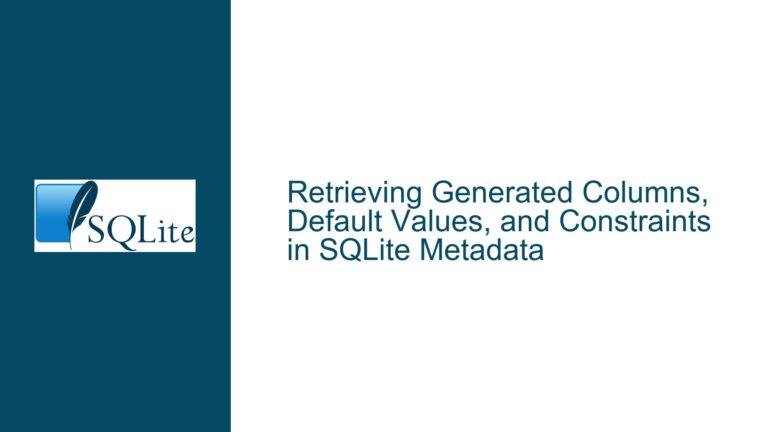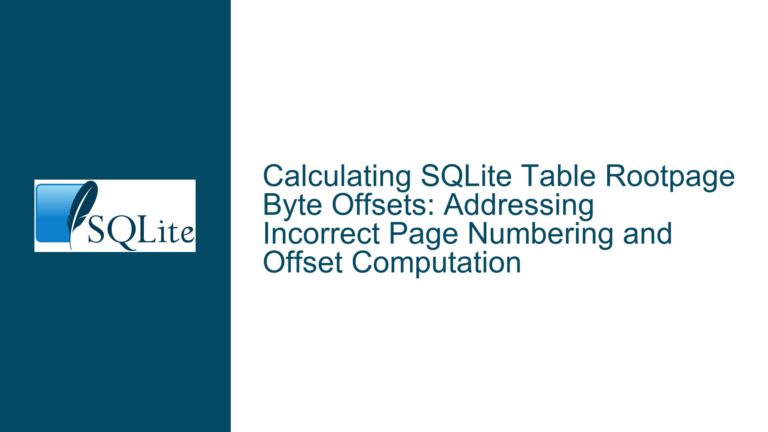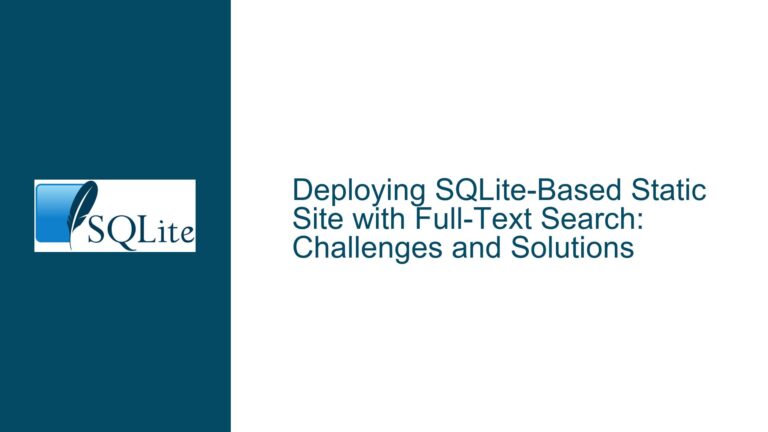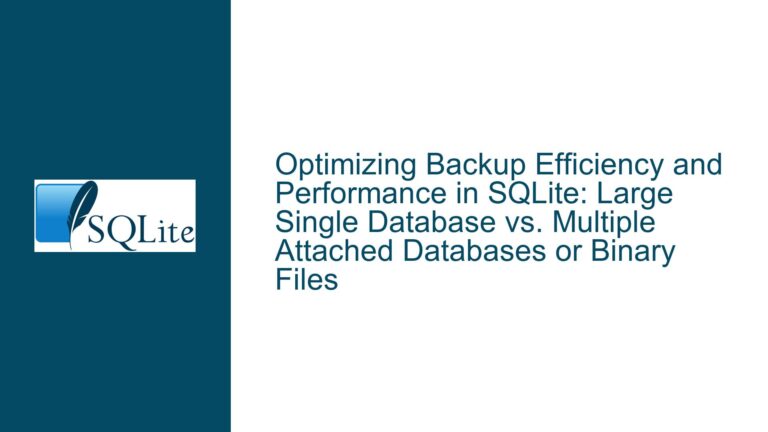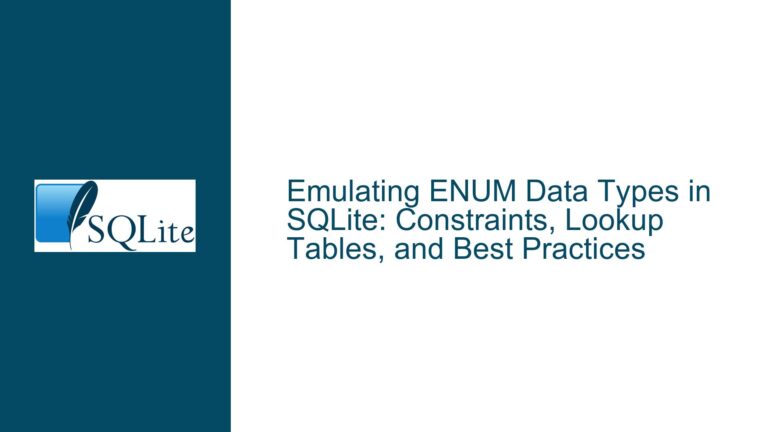Handling Monetary Values in SQLite: Data Types, Precision, and Best Practices
Monetary Value Storage Challenges in SQLite
The core issue revolves around how to represent monetary values in SQLite databases while ensuring accuracy, proper sorting, and compatibility with financial calculations. SQLite’s type system—which includes TEXT, INTEGER, REAL (floating-point), and BLOB—lacks a dedicated fixed-point decimal type commonly used for monetary values in other database systems. This absence creates ambiguity for developers designing schemas that handle currencies, tax calculations, or accounting systems.
Monetary values require exact precision to avoid rounding errors, especially in financial contexts like invoicing, double-entry bookkeeping, or tax computations. For example, storing "1.67" (USD $1.67) as TEXT allows preservation of the literal value but prevents arithmetic operations and introduces sorting issues (e.g., "13.50" appearing before "3.50" lexically). Using REAL introduces floating-point approximation errors due to IEEE 754 standards, which can magnify inaccuracies during calculations. Even minor discrepancies (e.g., 0.01 cent errors) become critical in financial systems where transactions must balance exactly.
The discussion highlights conflicting approaches:
- Integer-Based Storage: Storing values as integers in minor currency units (e.g., cents for USD).
- Floating-Point Storage: Using
REALwith careful precision management. - Textual Representation: Storing formatted strings like "$1.67" with currency symbols.
- SQLite Extensions: Leveraging non-core modules like the
decimalextension for fixed-point arithmetic.
Each method has trade-offs. For instance, integer storage ensures precision but requires application-layer logic to handle formatting and arithmetic. Floating-point introduces computational risks, while textual representations sacrifice functionality.
Root Causes of Precision and Data Type Misuse
1. SQLite’s Flexible Typing System
SQLite uses dynamic typing, allowing any type in any column (except INTEGER PRIMARY KEY). This flexibility can lead to accidental misuse. For example, a developer might define a column as INTEGER but insert fractional values, which SQLite will silently convert to REAL. Conversely, inserting numeric strings into TEXT columns bypasses validation, leading to sorting and comparison issues.
2. Lack of Built-In Fixed-Point Support
Unlike PostgreSQL’s NUMERIC or MySQL’s DECIMAL types, SQLite does not natively support fixed-point arithmetic. Developers must choose between:
- Integers: Exact but require scaling (e.g., storing cents instead of dollars).
- Strings: Human-readable but non-computable.
- Floats: Computable but inexact.
3. Input Handling Oversights
User interfaces that accept monetary values as free-form text (e.g., "$1.67") without validation or conversion to a numeric type risk storing invalid or inconsistently formatted data. For example, mixing currency symbols or decimal separators (e.g., "1,67" vs. "1.67") complicates parsing.
4. Misunderstanding Floating-Point Limitations
Floating-point numbers (REAL in SQLite) cannot precisely represent many decimal fractions. For example, 0.01 in IEEE 754 is stored as 0.010000000000000000208166817..., leading to cumulative errors in calculations. This makes REAL unsuitable for financial systems requiring exactness.
5. Ignoring STRICT Tables
SQLite 3.37.0+ introduced STRICT tables, which enforce column types. Without STRICT, a column defined as INTEGER can still store REAL values, undermining data integrity.
6. Currency Symbol Integration
Embedding currency symbols (e.g., "£1.67") in TEXT columns complicates arithmetic and sorting. Extracting numeric values requires additional parsing, increasing complexity.
Implementing Robust Monetary Handling with SQLite Features
Solution 1: Integer-Based Storage with Minor Units
Store monetary values as integers representing the smallest currency unit (e.g., cents for USD, pence for GBP). This avoids floating-point inaccuracies and ensures exact arithmetic.
Implementation Steps:
- Define Currency Configuration:
Create a table to track currency metadata, including the minor unit scale (e.g., 100 for USD, 1 for JPY).CREATE TABLE currencies ( code TEXT PRIMARY KEY, -- ISO 4217 code (e.g., "USD") symbol TEXT, -- "$" scale INTEGER -- 100 for USD (cents) ); - Store Values as Integers:
UseINTEGERcolumns scaled by the minor unit. For example, $1.67 becomes 167.CREATE TABLE transactions ( id INTEGER PRIMARY KEY, amount INTEGER, -- Stored in minor units (cents) currency_code TEXT, FOREIGN KEY (currency_code) REFERENCES currencies(code) ); - Application-Layer Scaling:
Convert user-entered values to integers during input and back to major units for display.
Solution 2: Enforce Type Integrity with STRICT Tables
Use STRICT mode to prevent invalid data types:
CREATE TABLE transactions (
id INTEGER PRIMARY KEY,
amount INTEGER,
currency_code TEXT
) STRICT;
Attempting to insert a non-integer into amount will now fail, ensuring data consistency.
Solution 3: Input Validation and Formatting
Implement application-level checks to:
- Reject non-numeric characters (e.g., "$" or ",").
- Validate decimal places against the currency’s minor unit scale.
- Use localized formatting libraries to handle regional differences (e.g., "," as decimal separator in Europe).
Solution 4: Views for Human-Readable Formatting
Create views to format stored integers as readable strings:
CREATE VIEW formatted_transactions AS
SELECT
id,
(amount * 1.0 / c.scale) AS amount_major,
c.symbol || (amount * 1.0 / c.scale) AS formatted
FROM transactions t
JOIN currencies c ON t.currency_code = c.code;
Solution 5: Avoid Floating-Point for Financial Calculations
If fractional values are unavoidable (e.g., unit prices), use REAL cautiously:
- Limit calculations to values within the precision of 64-bit floats (~15-17 significant digits).
- Round results to the nearest minor unit before storing.
Solution 6: Use the Decimal Extension for Fixed-Point
Compile SQLite with the decimal extension for fixed-point arithmetic:
-- Enable extension (if compiled in)
SELECT decimal_enable();
-- Create a table with decimal values
CREATE TABLE products (
price DECIMAL(10, 2) -- 10 digits, 2 decimal places
);
This stores values as strings with enforced precision, avoiding floating-point errors.
Solution 7: Currency-Aware Sorting and Filtering
For TEXT columns with currency symbols, extract numeric values using SQL functions:
-- Extract numeric value from "£1.67"
CAST(SUBSTR(amount, 2) AS REAL) AS numeric_value
However, prefer integer-based storage to avoid this complexity.
Solution 8: Audit and Reconciliation Mechanisms
Implement automated checks to ensure financial data integrity:
-- Verify that all transactions balance (double-entry accounting)
SELECT SUM(amount) FROM journal WHERE account_type = 'credit';
SELECT SUM(amount) FROM journal WHERE account_type = 'debit';
-- Both queries should return the same total
Solution 9: Handling Non-Decimal Currencies
For currencies like Malagasy Ariary (MGA, 5 subunits), adjust scaling factors:
INSERT INTO currencies (code, symbol, scale) VALUES ('MGA', 'Ar', 5);
Store 1.25 Ariary as 6 (1 * 5 + 0.25 * 5).
Solution 10: Testing and Edge Cases
Validate all monetary handling logic with test cases:
- Rounding rules (e.g., banker’s rounding).
- Overflow/underflow during arithmetic.
- Localization (e.g., comma vs. period as decimal separator).
By combining strict typing, integer-based storage, and application-layer validation, developers can mitigate the risks of monetary value handling in SQLite. While SQLite lacks native fixed-point types, disciplined schema design and input management provide robust alternatives suitable for financial applications.

